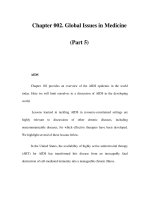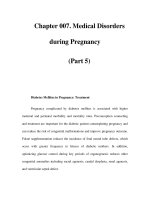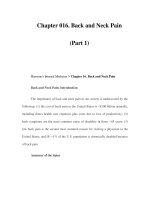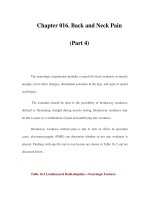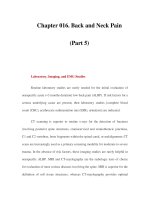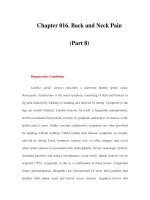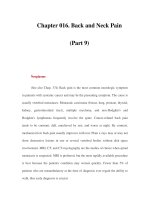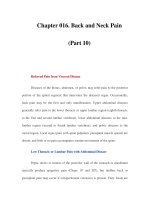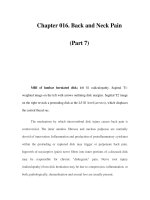Chapter 016. Back and Neck Pain (Part 5) pps
Bạn đang xem bản rút gọn của tài liệu. Xem và tải ngay bản đầy đủ của tài liệu tại đây (16.88 KB, 7 trang )
Chapter 016. Back and Neck Pain
(Part 5)
Laboratory, Imaging, and EMG Studies
Routine laboratory studies are rarely needed for the initial evaluation of
nonspecific acute (<3 months duration) low back pain (ALBP). If risk factors for a
serious underlying cause are present, then laboratory studies [complete blood
count (CBC), erythrocyte sedimentation rate (ESR), urinalysis] are indicated.
CT scanning is superior to routine x-rays for the detection of fractures
involving posterior spine structures, craniocervical and craniothoracic junctions,
C1 and C2 vertebrae, bone fragments within the spinal canal, or malalignment; CT
scans are increasingly used as a primary screening modality for moderate to severe
trauma. In the absence of risk factors, these imaging studies are rarely helpful in
nonspecific ALBP. MRI and CT-myelography are the radiologic tests of choice
for evaluation of most serious diseases involving the spine. MRI is superior for the
definition of soft tissue structures, whereas CT-myelography provides optimal
imaging of the lateral recess of the spinal canal and bony lesions and is tolerated
by claustrophobic patients. While the added diagnostic value of modern
neuroimaging is significant, there is concern that these studies may be overutilized
in patients with ALBP.
Electrodiagnostic studies can be used to assess the functional integrity of
the peripheral nervous system (Chap. e30). Sensory nerve conduction studies are
normal when focal sensory loss is due to nerve root damage because the nerve
roots are proximal to the nerve cell bodies in the dorsal root ganglia. The
diagnostic yield of needle EMG is higher than that of nerve conduction studies for
radiculopathy. Denervation changes in a myotomal (segmental) distribution are
detected by sampling multiple muscles supplied by different nerve roots and
nerves; the pattern of muscle involvement indicates the nerve root(s) responsible
for the injury. Needle EMG provides objective information about motor nerve
fiber injury when the clinical evaluation of weakness is limited by pain or poor
effort. EMG and nerve conduction studies will be normal when only limb pain or
sensory nerve root injury or irritation is present.
Causes of Back Pain
Table 16-3 Causes of Back and Neck Pain
Congenital/developmental
Spondylolysis and spondylolisthesisa
Kyphoscoliosis
a
Spina bifida occulta
a
Tethered spinal cord
a
Minor trauma
Strain or sprain
Whiplash injury
b
Fractures
Traumatic—falls, motor vehicle accidents
Atraumatic—osteoporosis, neoplastic infiltration, exogenous steroids
Intervertebral disk herniation
Degenerative
Disk-osteophyte complex
Internal disk disruption
Spinal stenosis with neurogenic claudication
a
Uncovertebral joint disease
b
Atlantoaxial joint disease (e.g., rheumatoid arthritis)
a
Arthritis
Spondylosis
Facet or sacroiliac arthropathy
Autoimmune (e.g., anklyosing spondylitis, Reiter's syndrome)
Neoplasms—metastatic, hematologic, primary bone tumors
Infection/inflammation
Vertebral osteomyelitis
Spinal epidural abscess
Septic disk
Meningitis
Lumbar arachnoiditis
a
Metabolic
Osteoporosis—hyperparathyroidism, immobility
Osteosclerosis (e.g., Paget's disease)
Vascular
Abdominal aortic aneurysm
Vertebral artery dissection
b
Other
Referred pain from visceral disease
Postural
Psychiatric, malingering, chronic pain syndromes
a
Low back pain only.
b
Neck pain only.
